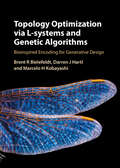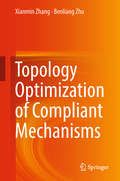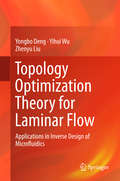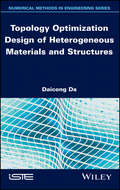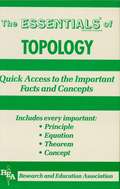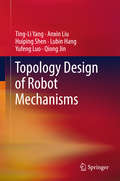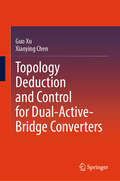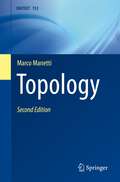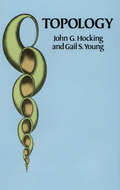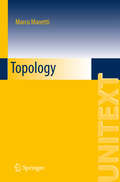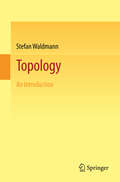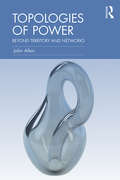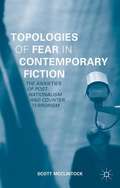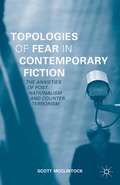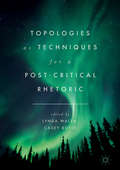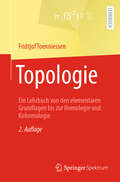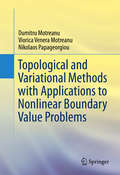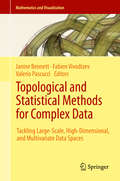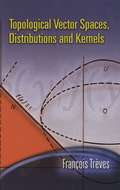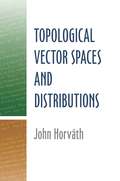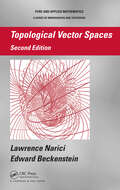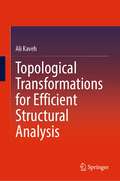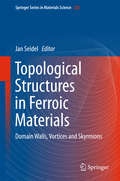- Table View
- List View
Topology Optimization via L-Systems and Genetic Algorithms: Bioinspired Encoding for Generative Design
by Darren J. Hartl Brent R. Bielefeldt Marcelo H. KobayashiProviding a succinct overview of Lindenmayer system (L-system) topology optimization, this book focuses on the methods and theory underlying this novel bioinspired approach. Starting from basic principles, the book outlines how topology optimization can be utilized at the conceptual design stage and shows how it offers straightforward applicability to multi-objective and/or multi-physical industrial problems. Design strategies are clearly demonstrated using a host of case studies and real-world examples, and their potential challenges and solutions are discussed. Written from an optimization and design perspective, the authors both summarize the latest advances in this field and suggest potential avenues of research and development for future work. This will be the ideal resource for engineering practitioners, researchers, and students wanting to gain a new perspective on using topology optimization to improve product design.
Topology Optimization of Compliant Mechanisms
by Xianmin Zhang Benliang ZhuThis book covers various topics regarding the design of compliant mechanisms using topology optimization that have attracted a great deal of attention in recent decades. After comprehensively describing state-of-the-art methods for designing compliant mechanisms, it provides a new topology optimization method for finding new flexure hinges. It then presents several attempts to obtain distributed compliant mechanisms using the topology optimization method. Further, it discusses a Jacobian-based topology optimization method for compliant parallel mechanisms, and introduces readers to the topology optimization of compliant mechanisms, taking into account geometrical nonlinearity and reliability. Providing a systematic method for topology optimization of flexure hinges, which are essential for designing compliant mechanisms, the book offers a valuable resource for all readers who are interested in designing compliant mechanism-based positioning stages. In addition, the methods for solving the de facto hinges in topology optimized compliant mechanisms will benefit all engineers seeking to design micro-electro-mechanical system (MEMS) structures.
Topology Optimization Theory for Laminar Flow
by Yongbo Deng Yihui Wu Zhenyu LiuThis book presents the topology optimization theory for laminar flows with low and moderate Reynolds numbers, based on the density method and level-set method, respectively. The density-method-based theory offers efficient convergence, while the level-set-method-based theory can provide anaccurate mathematical expression of the structural boundary. Unsteady, body-force-driven and two-phase properties are basic characteristics of the laminar flows. The book discusses these properties, which are typical of microfluidics and one of the research hotspots in the area of Micro-Electro-Mechanical Systems (MEMS), providing an efficient inverse design approach for microfluidic structures. To demonstrate the applications of this topology optimization theory in the context of microfluidics, it also investigates inverse design for the micromixer, microvalve and micropump, which are key elements in lab-on-chip devices.
Topology Optimization Design of Heterogeneous Materials and Structures
by Daicong DaThis book pursues optimal design from the perspective of mechanical properties and resistance to failure caused by cracks and fatigue. The book abandons the scale separation hypothesis and takes up phase-field modeling, which is at the cutting edge of research and is of high industrial and practical relevance. Part 1 starts by testing the limits of the homogenization-based approach when the size of the representative volume element is non-negligible compared to the structure. The book then introduces a non-local homogenization scheme to take into account the strain gradient effects. Using a phase field method, Part 2 offers three significant contributions concerning optimal placement of the inclusion phases. Respectively, these contributions take into account fractures in quasi-brittle materials, interface cracks and periodic composites. The topology optimization proposed has significantly increased the fracture resistance of the composites studied.
Topology Essentials
by Emil G. MilewskiREA's Essentials provide quick and easy access to critical information in a variety of different fields, ranging from the most basic to the most advanced. As its name implies, these concise, comprehensive study guides summarize the essentials of the field covered. Essentials are helpful when preparing for exams, doing homework and will remain a lasting reference source for students, teachers, and professionals. Topology includes an overview of elementary set theory, relations and functions, ordinals and cardinals, topological spaces, continuous functions, metric spaces and normed spaces, countable spaces, and separation axioms.
Topology Design of Robot Mechanisms
by Ting-Li Yang Anxin Liu Huiping Shen Lubin Hang Yufeng Luo Qiong JinThis book focuses on the topology theory of mechanisms developed by the authors and provides a systematic method for the topology design of parallel mechanisms (PMs). The main original theoretical contributions of this book include: (1) Three basic concepts (a) The "geometrical constraint type", kinematic pair and connection of links are three structural elements. As such, the symbolic expression of these mechanisms' structures is an invariance. (b) The position and orientation characteristic (POC) set describes the POC of relative motion between any two links and is an invariance. (c) In turn, the simple open chain (SOC) unit is used to develop four basic equations of mechanism topology (see Chapters 4 to 6). (2) Mechanism composition principle The book proposes a mechanism composition principle based on the SOC unit and establishes a systematic theory for the unified modeling of the topology, kinematics, and dynamics of mechanisms (see Chapter 7). (3) Four basic equations (a) A POC equation of serial mechanisms and its 10 operation rules (see Chapter 4). (b) A POC equation of PMs and its 14 operation rules (see Chapter 5). (c) The general DOF formulas (see Chapter 6). (d) The coupling degree formula for the Assur kinematic chain (see Chapter 7). (4) One systematic method for the topology design of parallel mechanisms (see Chapters 8-10) Drawing on these three basic concepts and four basic equations, the book puts forward a systematic method for the topology design of PMs, one that is fundamentally different from existing methods. Its main characteristics are as follows: (a) The design process includes two stages: the first is structure synthesis, which allows many structure types to be obtained; the second involves the performance analysis, classification and optimization of structure types. (b) The design operation is independent of the motion position and selection of fixed coordinate system. As such, the proposed method is essentially geometrical. This ensures that full-cycle DOF and the generality of geometric conditions of mechanism existence apply. (c) Each individual design step follows an explicit formula or the guidelines for design criteria, making the operation simple, feasible and reproducible. In addition, the topology design of the SCARA PM is studied in detail, providing an example to illustrate the proposed method (see Chapter 10).
Topology Deduction and Control for Dual-Active-Bridge Converters
by Guo Xu Xiaoying ChenThis book provides a comprehensive review and classification for dual active bridge DC-DC converters. Based on the unified topology architecture of the dual active bridge DC-DC converters, the topologies derivation law is studied and new converter topologies are deducted correspondingly. Several novel converters are provided to illustrate different topology modification methods, including modified IO types, modified active bridges, modified transformers, adding auxiliary high-frequency networks, and modular topology structure. Meanwhile, the control optimization and the parameter design of the novel converters are also investigated.
Topology (UNITEXT #153)
by Marco ManettiThis is an introductory textbook on general and algebraic topology, aimed at anyone with a basic knowledge of calculus and linear algebra. It provides full proofs and includes many examples and exercises. The covered topics include: set theory and cardinal arithmetic; axiom of choice and Zorn's lemma; topological spaces and continuous functions; con- nectedness and compactness; Alexandrov compactification; quotient topol- ogies; countability and separation axioms; prebasis and Alexander's theorem; the Tychonoff theorem and paracompactness; complete metric spaces and function spaces; Baire spaces; homotopy of maps; the fundamental group; the van Kampen theorem; covering spaces; Brouwer and Borsuk's theorems; free groups and free product of groups and basic category theory. While it is very concrete at the beginning, abstract concepts are gradually introduced. This second edition contains a new chapter with a topological introduction to sheaf cohomology and applications. It also corrects some inaccuracies and some additional exercises are proposed. The textbook is suitable for anyone needing a basic, comprehensive introduction to general and algebraic topology and its applications.
Topology
by John G. Hocking Gail S. Young"As textbook and reference work, this is a valuable addition to the topological literature." -- Mathematical ReviewsDesigned as a text for a one-year first course in topology, this authoritative volume offers an excellent general treatment of the main ideas of topology. It includes a large number and variety of topics from classical topology as well as newer areas of research activity.There are four set-theoretic chapters, followed by four primarily algebraic chapters. Chapter I covers the fundamentals of topological and metrical spaces, mappings, compactness, product spaces, the Tychonoff theorem, function spaces, uniform continuity and uniform spaces. The next two chapters are devoted to topics in point-set topology: various separation axioms, continua in Hausdorff spaces, real-valued functions, and more Chapter IV is on homotopy theory. Chapter V covers basic material on geometric and abstract simplicial complexes and their subdivisions. Chapter VI is devoted to simplicial homology theory, Chapter VII covers various topics in algebraic topology, including relative homology, exact sequences, the Mayer-Vietoris sequence, and more. Finally, Chapter VIII discusses Cech homology.There are a large number of illuminating examples, counter-examples and problems, both those which test the understanding and those which deepen it. The authors have also made a special effort to make this an "open-ended" book, i.e while many topics are covered, there is much beyond the confines of this book. In many instances they have attempted to show the direction in which further material may be found.Topology is so fundamental, its influence is apparent in almost every other branch of mathematics, as well as such fields as symbolic logic, mechanics, geography, network theory, and even psychology. This well-written text offers a clear and careful exposition of this increasingly important discipline.
Topology
by Marco ManettiThis is an introductory textbook on general and algebraic topology, aimed at anyone with a basic knowledge of calculus and linear algebra. It provides full proofs and includes many examples and exercises. The covered topics include: set theory and cardinal arithmetic; axiom of choice and Zorn's lemma; topological spaces and continuous functions; connectedness and compactness; Alexandrov compactification; quotient topologies; countability and separation axioms; prebasis and Alexander's theorem; the Tychonoff theorem and paracompactness; complete metric spaces and function spaces; Baire spaces; homotopy of maps; the fundamental group; the van Kampen theorem; covering spaces; Brouwer and Borsuk's theorems; free groups and free product of groups; and basic category theory. While it is very concrete at the beginning, abstract concepts are gradually introduced. It is suitable for anyone needing a basic, comprehensive introduction to general and algebraic topology and its applications.
Topology
by Stefan WaldmannThis book provides a concise introduction to topology and is necessary for courses in differential geometry, functional analysis, algebraic topology, etc. Topology is a fundamental tool in most branches of pure mathematics and is also omnipresent in more applied parts of mathematics. Therefore students will need fundamental topological notions already at an early stage in their bachelor programs. While there are already many excellent monographs on general topology, most of them are too large for a first bachelor course. Topology fills this gap and can be either used for self-study or as the basis of a topology course.
Topologies of Power: Beyond territory and networks (CRESC)
by John AllenTopologies of Power amounts to a radical departure in the way that power and space have been understood. It calls into question the very idea that power is simply extended across a given territory or network, and argues that power today has a new found ‘reach’. Topological shifts have subtly altered the reach of power, enabling governments, corporations and NGOs alike to register their presence through quieter, less brash forms of power than domination or overt control. In a world in which proximity and distance increasingly play across one another, topology offers an insight into how power remains continuous under transformation: the same but different in its ability to shape peoples’ lives. Drawing upon a range of political, economic and cultural illustrations, the book sets out a clear and accessible account of the topological workings of power in the contemporary moment. It will be invaluable for both students and academics in human geography, politics, sociology, and cultural studies.
Topologies of Fear in Contemporary Fiction: The Anxieties of Post-Nationalism and Counter Terrorism
by Scott McClintockThe central concern of the book is the impact of global terror networks and state counterterrorism on twentieth-century fiction. A unique contribution of this book is the comparative approach, as opposed to the single author focus of most of the edited collections on terrorism in literature.
Topologies of Fear in Contemporary Fiction: The Anxieties of Post-Nationalism and Counter Terrorism
by Scott McClintockThe central concern of the book is the impact of global terror networks and state counterterrorism on twentieth-century fiction. A unique contribution of this book is the comparative approach, as opposed to the single author focus of most of the edited collections on terrorism in literature.
Topologies of Digital Work: How Digitalisation and Virtualisation Shape Working Spaces and Places (Dynamics of Virtual Work)
by Mascha Will-Zocholl Caroline Roth-EbnerThis book provides a unique contribution to the controversial discussion that surrounds the digitalisation and virtualisation of work. With a focus on the new formation of space and place, it critically discusses the idea that places in the context of work are increasingly losing their importance, and becoming more arbitrary with new technical possibilities. Theoretical considerations that deal conceptually with the understanding of space and work are taken into account, as well as empirical results from different professional and work fields across various regions of our globalised world. The book is applicable to researchers and students of sociology of work, media and communications, organization studies, workplace studies, labour process studies, economics, human geography, anthropology and learning sciences.Chapter 1, 4 and 11 are available open access under a Creative Commons Attribution 4.0 International License via link.springer.com.
Topologies as Techniques for a Post-Critical Rhetoric
by Lynda Walsh Casey BoyleThis book restores the concept of topology to its rhetorical roots to assist scholars who wish not just to criticize power dynamics, but also to invent alternatives. Topology is a spatial rather than a causal method. It works inductively to model discourse without reducing it to the actions of a few or resolving its inherent contradictions. By putting topology back in tension with opportunity, as originally designed, the contributors to this volume open up new possibilities for post-critical practice in "wicked discourses" of medicine, technology, literacy, and the environment. Readers of the volume will discover exactly how the discipline of rhetoric underscores and interacts with current notions of topology in philosophy, design, psychoanalysis, and science studies.
Topologie: Ein Lehrbuch von den elementaren Grundlagen bis zur Homologie und Kohomologie
by Fridtjof ToenniessenDiese Einführung in die Topologie spannt einen weiten Bogen, von den elementaren Grundlagen über fortgeschrittene Themen der algebraischen Topologie bis hin zu tiefer liegenden Meilensteinen, die im 20. Jahrhundert Furore gemacht haben. Der Text ist durchgängig einfach geschrieben, braucht nur wenig Vorwissen und ist daher gut geeignet ab etwa dem dritten Semester eines mathematischen Bachelorstudiums. Er wurde für die 2. Auflage vollständig durchgesehen, didaktisch und redaktionell überarbeitet sowie in weiten Teilen ergänzt und korrigiert. Erhalten blieb dabei der aufgelockerte Lesebuch-Charakter. So erfahren Sie bei der Lektüre hie und da historische Fakten oder werden in die Gedankengänge von Mathematikern versetzt, um die Entstehung der Theorie Schritt für Schritt nacherleben zu können. Dabei geht es naturgemäß nicht immer geradeaus, manchmal führe ich Sie auf Holzwege, die einerseits zum Nachdenken und zu einer kritischen Reflexion anregen, andererseits aber auch zeigen sollen, dass die Definitionen nicht einfach vom Himmel gefallen sind, sondern sich organisch entwickelt haben. Zahlreiche konkrete Beispiele und fast 400 Abbildungen runden den Stoff ab.
Topological and Variational Methods with Applications to Nonlinear Boundary Value Problems
by Dumitru Motreanu Viorica Venera Motreanu Nikolaos PapageorgiouThis book focuses on nonlinear boundary value problems and the aspects of nonlinear analysis which are necessary to their study. The authors first give a comprehensive introduction to the many different classical methods from nonlinear analysis, variational principles, and Morse theory. They then provide a rigorous and detailed treatment of the relevant areas of nonlinear analysis with new applications to nonlinear boundary value problems for both ordinary and partial differential equations. Recent results on the existence and multiplicity of critical points for both smooth and nonsmooth functional, developments on the degree theory of monotone type operators, nonlinear maximum and comparison principles for p-Laplacian type operators, and new developments on nonlinear Neumann problems involving non-homogeneous differential operators appear for the first time in book form. The presentation is systematic, and an extensive bibliography and a remarks section at the end of each chapter highlight the text. This work will serve as an invaluable reference for researchers working in nonlinear analysis and partial differential equations as well as a useful tool for all those interested in the topics presented.
Topological and Statistical Methods for Complex Data
by Valerio Pascucci Janine Bennett Fabien VivodtzevThis book contains papers presented at the Workshop on the Analysis of Large-scale, High-Dimensional, and Multi-Variate Data Using Topology and Statistics, held in Le Barp, France, June 2013. It features the work of some of the most prominent and recognized leaders in the field who examine challenges as well as detail solutions to the analysis of extreme scale data. The book presents new methods that leverage the mutual strengths of both topological and statistical techniques to support the management, analysis, and visualization of complex data. It covers both theory and application and provides readers with an overview of important key concepts and the latest research trends. Coverage in the book includes multi-variate and/or high-dimensional analysis techniques, feature-based statistical methods, combinatorial algorithms, scalable statistics algorithms, scalar and vector field topology, and multi-scale representations. In addition, the book details algorithms that are broadly applicable and can be used by application scientists to glean insight from a wide range of complex data sets.
Topological and Non-Topological Solitons in Scalar Field Theories (Cambridge Monographs on Mathematical Physics)
by Yakov M. ShnirSolitons emerge in various non-linear systems as stable localized configurations, behaving in many ways like particles, from non-linear optics and condensed matter to nuclear physics, cosmology and supersymmetric theories. This book provides an introduction to integrable and non-integrable scalar field models with topological and non-topological soliton solutions. Focusing on both topological and non-topological solitons, it brings together debates around solitary waves and construction of soliton solutions in various models and provides a discussion of solitons using simple model examples. These include the Kortenweg-de-Vries system, sine-Gordon model, kinks and oscillons, and skyrmions and hopfions. The classical field theory of scalar field in various spatial dimensions is used throughout the book in presentation of related concepts, both at the technical and conceptual level. Providing a comprehensive introduction to the description and construction of solitons, this book is ideal for researchers and graduate students in mathematics and theoretical physics.
Topological Vector Spaces, Distributions and Kernels: Pure And Applied Mathematics (Dover Books on Mathematics #Volume 25)
by Francois TrevesThis text for upper-level undergraduates and graduate students focuses on key notions and results in functional analysis. Extending beyond the boundaries of Hilbert and Banach space theory, it explores aspects of analysis relevant to the solution of partial differential equations.The three-part treatment begins with topological vector spaces and spaces of functions, progressing to duality and spaces of distribution, and concluding with tensor products and kernels. The archetypes of linear partial differential equations (Laplace's, the wave, and the heat equations) and the traditional problems (Dirichlet's and Cauchy's) are this volume's main focus. Most of the basic classical results appear here. There are 390 exercises, several of which contain detailed information that will enable readers to reconstruct the proofs of some important results.
Topological Vector Spaces and Distributions
by John HorvathMathematically rigorous but user-friendly, this classic treatise discusses major modern contributions to the field of topological vector spaces. The self-contained treatment includes complete proofs for all necessary results from algebra and topology. Suitable for undergraduate mathematics majors with a background in advanced calculus, this volume will also assist professional mathematicians, physicists, and engineers.The precise exposition of the first three chapters--covering Banach spaces, locally convex spaces, and duality--provides an excellent summary of the modern theory of locally convex spaces. The fourth and final chapter develops the theory of distributions in relation to convolutions, tensor products, and Fourier transforms. Augmented with many examples and exercises, the text includes an extensive bibliography.
Topological Vector Spaces (Chapman & Hall/CRC Pure and Applied Mathematics)
by Lawrence Narici Edward BeckensteinWith many new concrete examples and historical notes, Topological Vector Spaces, Second Edition provides one of the most thorough and up-to-date treatments of the Hahn-Banach theorem. This edition explores the theorem's connection with the axiom of choice, discusses the uniqueness of Hahn-Banach extensions, and includes an entirely new chapter on v
Topological Transformations for Efficient Structural Analysis
by Ali KavehThe author has published many papers and books on topological transformations for optimal analysis of structures, where many methods and algorithms are developed. However, the framework of this book generalizes many concepts and makes the previously developed methods conceptually more attractive. The aim of the present work is two folds. On the one hand, it shows to mathematicians how the apparently pure mathematical concepts can be applied to the efficient solution of problems in structural mechanics. On the other hand, it illustrates to engineers the important role of mathematical concepts for the solution of engineering problems. The present framework provides efficient means for looking at problems and developing ideas by transforming the models (structures, networks, systems) to other spaces (higher dimension, lower dimension, or identical dimension) to simplify the problems.This book is attractive for those who look at the deeper aspects of concepts and helps the reader to develop his/her own ideas. In general, it opens a new horizon for improving the existing methods in civil, mechanical, and electrical engineering.
Topological Structures in Ferroic Materials
by Jan SeidelThis book provides a state-of-the art overview of a highly interesting emerging research field in solid state physics/nanomaterials science, topological structures in ferroic materials. Topological structures in ferroic materials have received strongly increasing attention in the last few years. Such structures include domain walls, skyrmions and vortices, which can form in ferroelectric, magnetic, ferroelastic or multiferroic materials. These topological structures can have completely different properties from the bulk material they form in. They also can be controlled by external fields (electrical, magnetic, strain) or currents, which makes them interesting from a fundamental research point of view as well as for potential novel nanomaterials applications. To provide a comprehensive overview, international leading researches in these fields contributed review-like chapters about their own work and the work of other researchers to provide a current view of this highly interesting topic.
